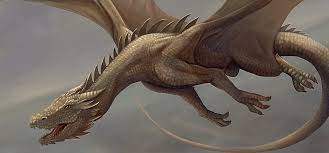Redfrogcrab
 Troubadour
Troubadour
Howdy yall
Using the powers of evolutionary biology and general biology, I will provide an analysis of dragons (and variants) and how they could realistically evolve within this thread, suggestions and comments are greatly appreciated
First up: Standard dragons

The big problem anatomically (besides fire breathing) is the wings and where they're placed on the body.
In yee classic mid-evil dragons, the wings are placed directly on the back, typically in evolution, vertebrates that are capable of powered flight adapt their forelimbs into wing structures, why?
for one, musculature, limbs need musculature, terrestrial legs, and arms, need some musculature, but wings need LOTS of it. Wings generate thrust by flapping, and thrust, paired with lift, lets you fly in the sky, the powerful muscles required for this also need anchor points, usually bones like a pelvis or shoulder blade, thus back wings are not possible, hell, that's not how evolution works.
Typically, tetrapods don't just add new limbs, all tetrapods (p.s. tetrapods are all reptiles, birds, amphibians, and mammals) have (or, at least have vestigial structures of) 4 distinct limbs.
Therefore, either
A. classic Dragons are not true reptiles (or even true tetrapods) but are instead a distinct class of terrestrial vertebrates (that I will dub Hexapoda) that convergently evolved a lot of tetrapod features (limbs, lungs, and specifically for dragons, scaly skin and amniotic eggs) but have an extra pair of limbs. It's my personal theory that the wings of classic dragons are the middle pair of limbs that have evolved to be wings.
B. somehow, some way, a group of reptiles just randomly got an extra set of limbs
dragons would have to be small and lightweight too, more mass means more thrust, and more thrust means more energy is used. I'd say the largest a dragon could get is about the size of a giraffe (as that's about the size of Quetzaquatlus, the largest flying animal ever, got)
In short, classical dragons would probably not be closely related to any tetrapod species, and be their own class of terrestrial vertebrates with 6 limbs instead of 4
Secondary problem with classic dragons: Fire breathing
This is actually something I could see naturally developing, kinda. Who said that the fire breathing had to be with an actual fire? certain ant species and a species of beetle have developed ways to spit out acidic compounds that sting like hell, and guess what vertebrates have in their stomachs, that's right, Highly acidic liquids. I believe that the dragon's "fire breath" is actually them spitting out stomach acid on prey, originally as a way to ease digestion, now just straight up spitting acid on prey (and mid-evil villages) to both kill and pre-digest (kinda like some spider species).
Using the powers of evolutionary biology and general biology, I will provide an analysis of dragons (and variants) and how they could realistically evolve within this thread, suggestions and comments are greatly appreciated
First up: Standard dragons

The big problem anatomically (besides fire breathing) is the wings and where they're placed on the body.
In yee classic mid-evil dragons, the wings are placed directly on the back, typically in evolution, vertebrates that are capable of powered flight adapt their forelimbs into wing structures, why?
for one, musculature, limbs need musculature, terrestrial legs, and arms, need some musculature, but wings need LOTS of it. Wings generate thrust by flapping, and thrust, paired with lift, lets you fly in the sky, the powerful muscles required for this also need anchor points, usually bones like a pelvis or shoulder blade, thus back wings are not possible, hell, that's not how evolution works.
Typically, tetrapods don't just add new limbs, all tetrapods (p.s. tetrapods are all reptiles, birds, amphibians, and mammals) have (or, at least have vestigial structures of) 4 distinct limbs.
Therefore, either
A. classic Dragons are not true reptiles (or even true tetrapods) but are instead a distinct class of terrestrial vertebrates (that I will dub Hexapoda) that convergently evolved a lot of tetrapod features (limbs, lungs, and specifically for dragons, scaly skin and amniotic eggs) but have an extra pair of limbs. It's my personal theory that the wings of classic dragons are the middle pair of limbs that have evolved to be wings.
B. somehow, some way, a group of reptiles just randomly got an extra set of limbs
dragons would have to be small and lightweight too, more mass means more thrust, and more thrust means more energy is used. I'd say the largest a dragon could get is about the size of a giraffe (as that's about the size of Quetzaquatlus, the largest flying animal ever, got)
In short, classical dragons would probably not be closely related to any tetrapod species, and be their own class of terrestrial vertebrates with 6 limbs instead of 4
Secondary problem with classic dragons: Fire breathing
This is actually something I could see naturally developing, kinda. Who said that the fire breathing had to be with an actual fire? certain ant species and a species of beetle have developed ways to spit out acidic compounds that sting like hell, and guess what vertebrates have in their stomachs, that's right, Highly acidic liquids. I believe that the dragon's "fire breath" is actually them spitting out stomach acid on prey, originally as a way to ease digestion, now just straight up spitting acid on prey (and mid-evil villages) to both kill and pre-digest (kinda like some spider species).

 Myth Weaver
Myth Weaver
 Maester
Maester